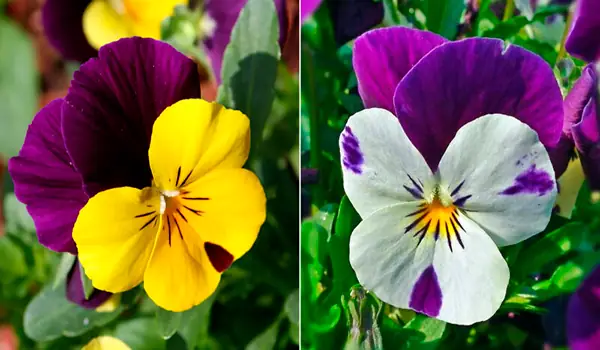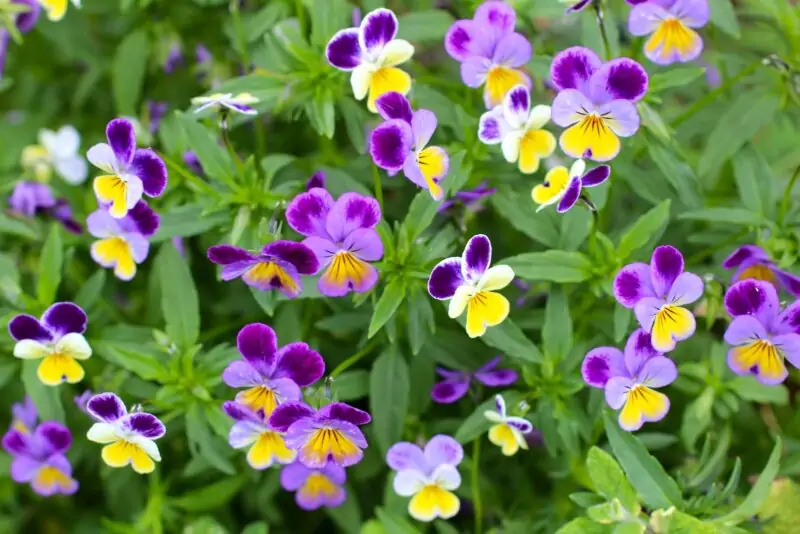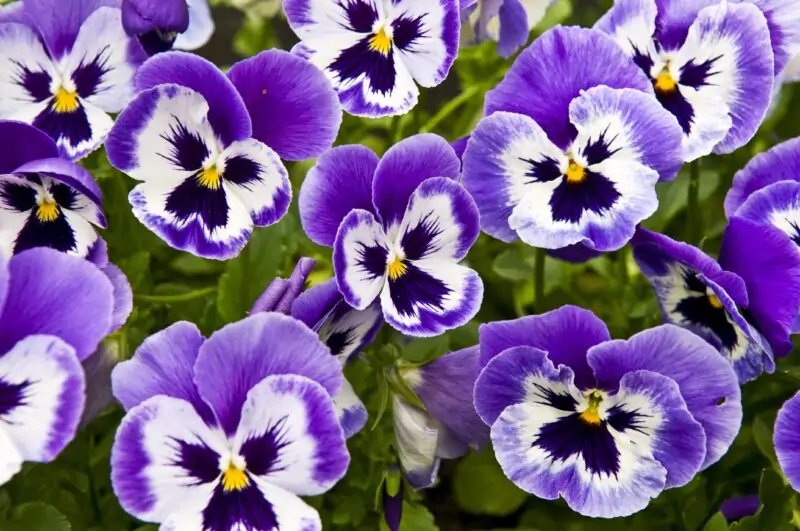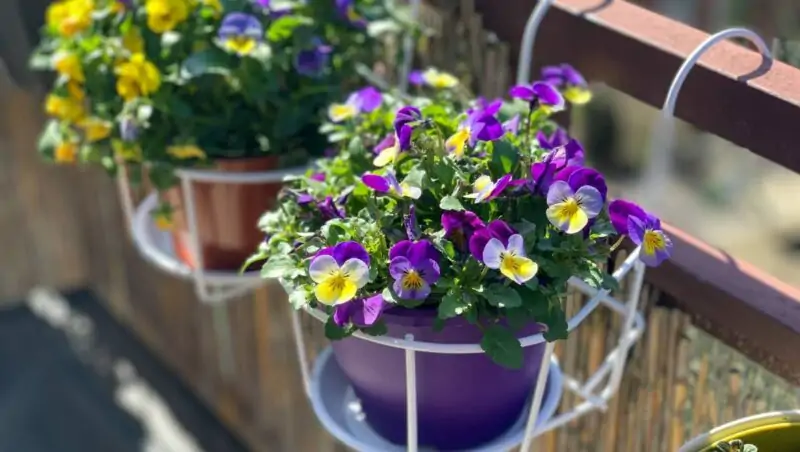Pansies and Violas: Exploring the Differences

Do you love flowers? If so, then violas and pansies should be on your list for your garden. These beautiful flowers are in the same family, but they have unique differences in the great “viola vs pansy” debate. They’re easy to grow, and they come in various colors and patterns. With the right care, they can bloom all year round.
This article will delve into these charming flowers. We’ll explore their characteristics, differences, and how to decide which one is best for your garden.
A Look at the Viola
Violas, sometimes called johnny jump-ups, are small flowering plants that belong to the Violaceae family. These perennial plants are low-growing and produce delicate blooms. The colors range from blue-violet hues to white or yellow shades. The leaves of the viola form attractive rosettes near their base, making them a beautiful addition to any garden.
The most popular species is Viola tricolor, also known as the wild pansy. It has been used as a remedy for respiratory issues like coughs, colds, flu, asthma, bronchitis, and hay fever since ancient times.

Snapshot of the Pansy
Like violas, pansies also belong to the Violaceae family. However, they’re larger than violas. They typically grow up to 8 inches tall and produce large, colorful blooms that measure about 2-3″ across. The petals overlap, forming what some people describe as “faces.”
These annual bloomers brighten gardens during the cooler months. They thrive from fall through winter. This is thanks to their ability to thrive in full sun and partial shade environments. This makes them a great choice for plant lovers living outside hardiness zones. Planting springtime annuals isn’t practical in these zones without high-maintenance requirements like heating greenhouses during colder periods.

Understanding the Two Flowers: Violas and Pansies
Violas
Violas offer many benefits beyond their beauty. They are incredibly resilient and can tolerate harsh weather conditions. Violas thrive in cool, moist environments and can also grow well during warmer seasons if the soil stays hydrated.
Another great thing about violas is their versatility. You can plant them together or mix them with other flowers, such as pansies. This creates a stunning backdrop for your garden.
Pansy Plants
Pansies require minimal maintenance. This makes it easy for both novice and expert flower enthusiasts to enjoy these beautiful blooms all year round! These plants come in many colors. This includes solid shades of purple, orange, pink, and yellow. Some even sport ‘faces’!
What’s more, pansies prefer environments with full sun or partial shade. They’re a perfect choice for anyone who loves gardening but doesn’t want to worry about upkeep. These plants self-seed readily!
Viola Vs. Pansy: Unveiling The Differences
Difference Between Pansies And Violas
Violas have smaller leaves than pansies. However, they tend to produce more flowers during the blooming season. Pansies, on the other hand, boast large, impressive blossoms. Each petal overlaps another, forming what some people refer to as “faces.”
Another difference lies in their hardiness, especially regarding cold tolerance. In colder regions where temperatures dip below freezing, only violas can withstand the frigid climates. They maintain their lively beauty throughout the winter months. Meanwhile, less hardy plants like annual bloomers may not last through frost periods if planted late.
Finally, there’s the color range. This is often limited when shopping around local nurseries. Thankfully, newer hybrid varieties provide growers with an expanded palette. This ranges from solid pastels to bold, contrasting combinations never seen before!
Viola Tricolor vs. Pansy Flowers: A Detailed Look
When it comes to eye-catching and easy-to-care-for flowers, both viola tricolor and pansies are fantastic choices. However, while they’re closely related and often mistaken for one another, there are several key differences between them. Let’s take a detailed look at these two popular flowers.
Origins and Taxonomy
Both viola tricolor and pansies belong to the Viola genus, which encompasses around 500 species. Viola tricolor, commonly known as Johnny Jump Up, heartsease, or wild pansy, is a wildflower native to Europe. Pansies, on the other hand, are hybrids derived primarily from Viola tricolor. They were cultivated for their larger flower size and diverse colors, and are often referred to as Viola x wittrockiana.
Appearance
The main difference between viola tricolor and pansies is their appearance. Viola tricolor flowers are smaller, typically around 1.5 cm in diameter, with a charming, slightly wild look. They have three colors: purple, yellow, and white, which is how they got their name ‘tricolor.’
Pansies, meanwhile, have larger blooms, typically 6 to 9 cm in diameter. They also come in a broader range of colors, including various shades of blue, purple, yellow, red, orange, white, and even black. Some pansies have a single color, while others have a beautiful ‘face,’ a darker area in the center which often features a contrasting color.
Growth Habit and Seasonality
Viola tricolor is a perennial plant and often self-seeds, meaning it can come back year after year. It blooms from spring to autumn, and in mild climates, it can even bloom all year round.
Pansies, however, are usually grown as annuals or biennials. They prefer cooler weather and often bloom in the spring and fall. In some regions, they can also bloom during the winter.
Care and Maintenance
Both viola tricolor and pansies are relatively easy to care for. They prefer well-drained soil and a location with full sun to partial shade. Regular deadheading can encourage more blooms and extend the flowering period.
In summary, both viola tricolor and pansies are excellent choices for adding color to your garden. If you prefer smaller, more delicate flowers and a slightly wilder look, viola tricolor might be the perfect choice for you. If you’re after larger, showier blooms with a wide range of colors, then pansies might be a better fit. Either way, both of these flowers are sure to bring joy to your garden.
Pansies and Violas: Ideal for Hanging Baskets and Window Boxes

Pansies and violas are perfect for hanging baskets and window boxes. Their vibrant colors and patterns can add a beautiful touch to any outdoor space. Hanging baskets provide ideal conditions for these plants, as they allow for good air circulation and easy watering. Similarly, window boxes offer a great platform for showcasing the bright colors of these flowers, particularly if you live in an apartment or have limited garden space.
Deadheading Pansies and Violas
To keep your pansies and violas looking their best, it’s important to regularly deadhead them. Deadheading is the process of removing faded or dead flowers. This not only keeps your plants looking neat and tidy, but it also encourages them to produce more blooms.
To deadhead your pansies or violas, simply pinch off the faded flower at the base of the bloom. Use a pair of scissors or your fingers to do this. Be careful not to damage the leaf cluster below the flower.
Pansies and Violas in the Hot Summer
While pansies and violas are cool season annuals, they can also tolerate heat and cold to some extent. However, during the hot summer months, it’s important to provide them with some shade during the hottest part of the day. You can do this by positioning them in a location that gets morning sun and afternoon shade.
In addition, be sure to water your pansies and violas regularly during the summer months. They prefer moist, but not waterlogged, soil. If the plants get too dry, they may start to wilt.
FAQs
Absolutely, you can! Pansies and violas are like two peas in a pod. They make quite the duo in pots or garden beds. Their similar growing needs make them easy as pie to care for together.
Great question! Pansies are technically short-lived perennials. But bless their hearts, they behave as annuals in most areas. However, some varieties of pansy plants may surprise you and come back year after year if the conditions are just right.
Well, violas and pansy plants aren’t too picky. They like their soil to stay moist but not too soggy. A good rule of thumb is to water them whenever the top inch of soil feels dry to the touch.
Yes siree! Deadheading is key to keep these little guys blooming for as long as possible. By removing spent flowers before they start making seeds, you also encourage a bushier growth habit.
Conclusion
Whether you’re a novice gardener or a seasoned green thumb, the “Viola vs Pansy” debate is one that can leave you pondering. Both Viola tricolor (viola) and Viola x wittrockiana (pansy) are delightful additions to any garden, each offering its own unique charm. They are cold-tolerant, come in a variety of stunning colors, and bring an undeniable vibrancy to your garden.
So, whether it’s the delicate, smaller blooms of violas, the flamboyant, larger blossoms of pansies, or a mix of both, don’t hesitate to make these flowers a part of your horticultural repertoire. After all, both pansies and violas carry a shared heritage in the viola family, and either one will surely brighten your garden during the cooler seasons. The “Viola vs Pansy” decision is not about choosing one over the other, but about celebrating the unique beauty each brings. Now, get your gardening gloves on and start planting!